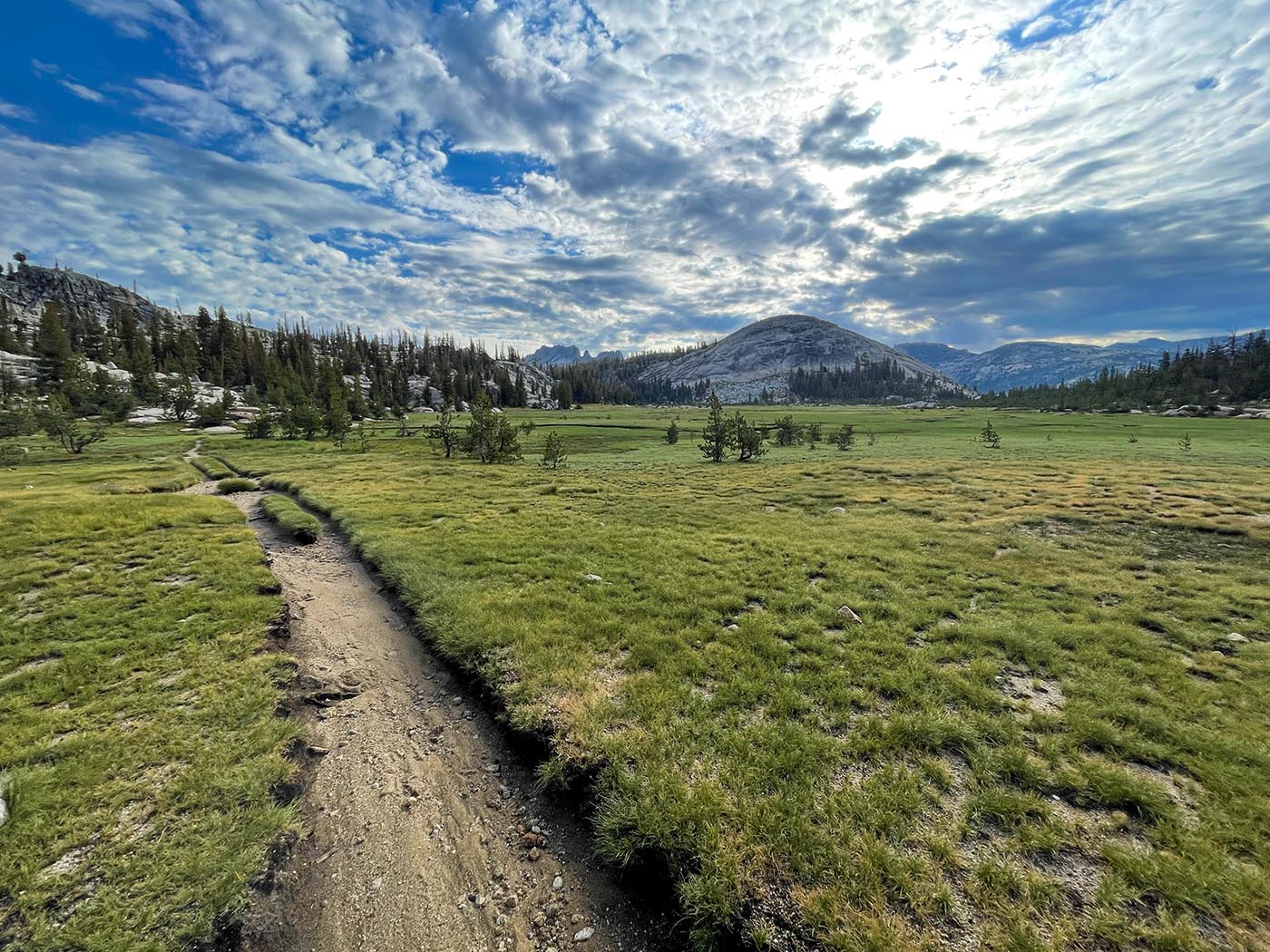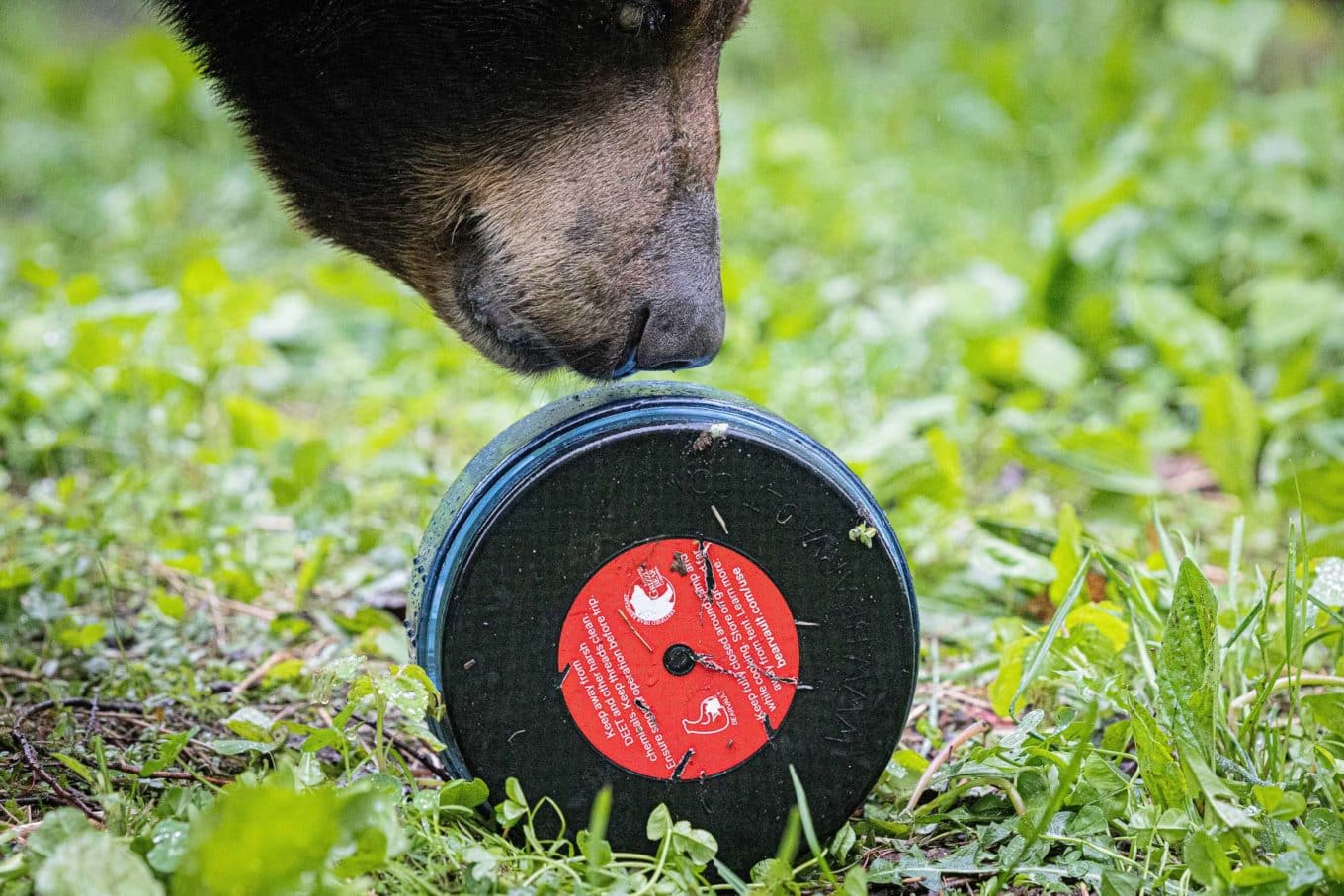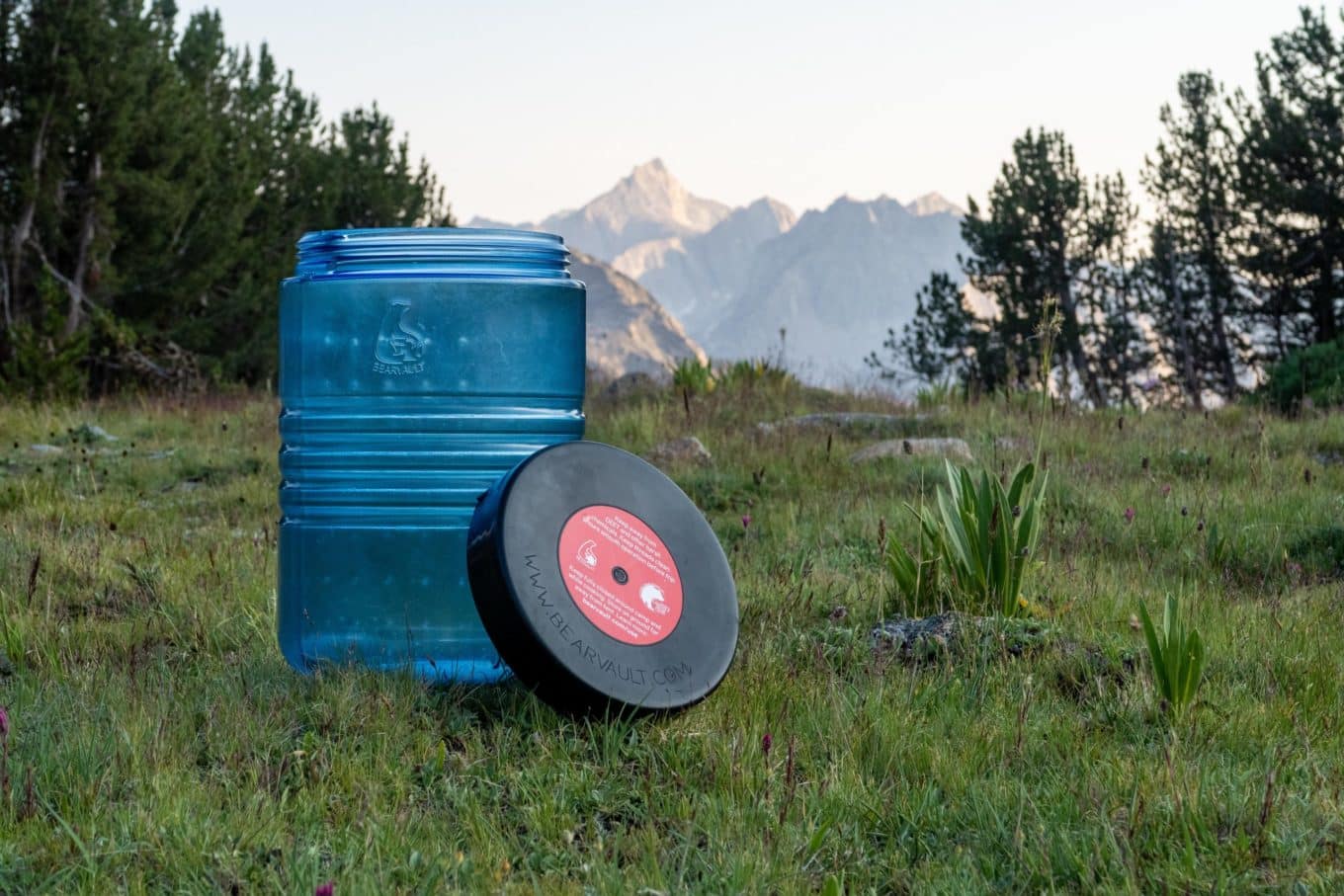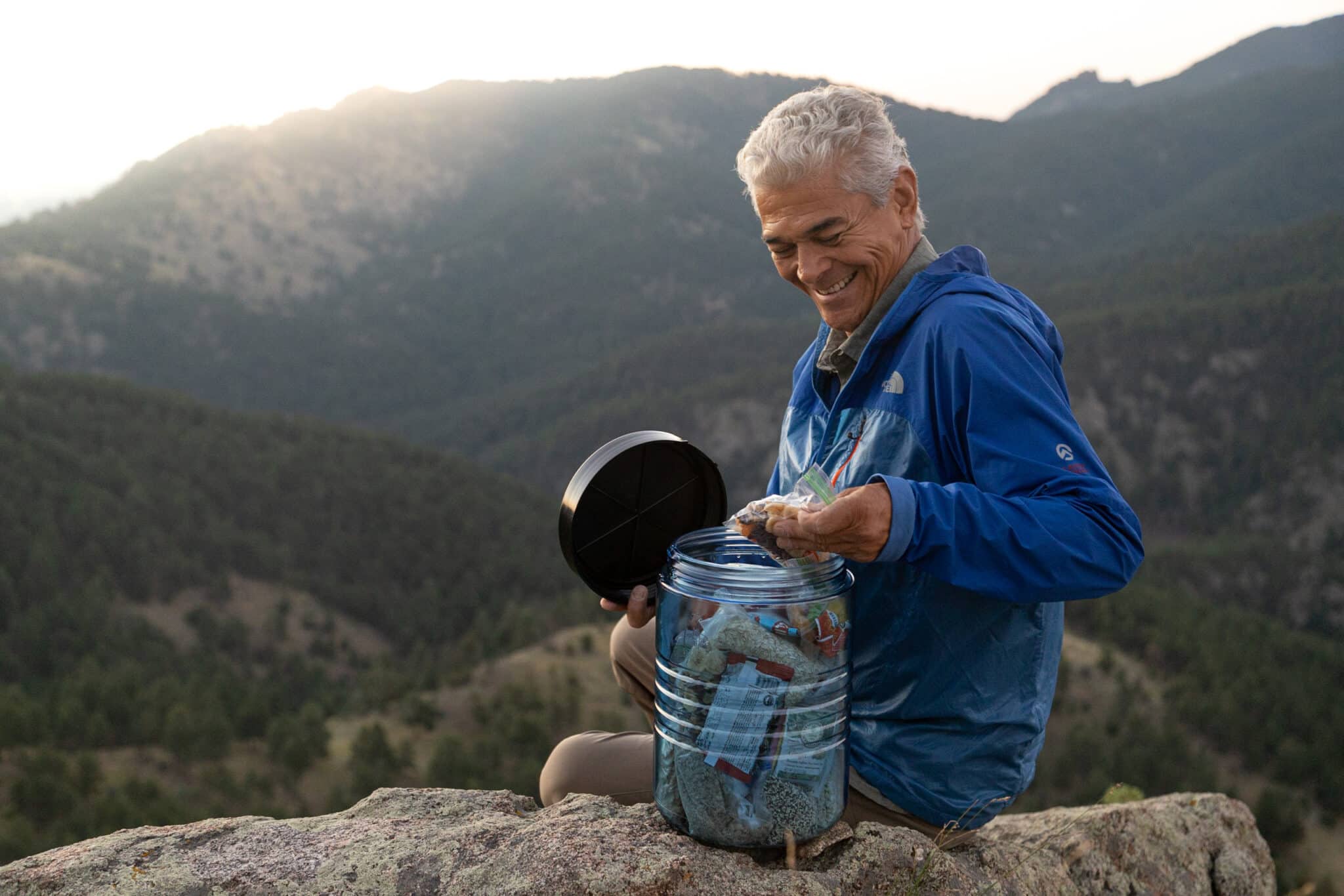Bear Canister vs Bear Bag: How Do You Choose?
When it comes to food security in the backcountry, there are really only two portable options on the market. Since protecting your food is essential not only to the success of your adventure but also the longevity of your destination’s wildlife, every outdoorist must choose…
Bear canister? Or bear bag?
In this blog we’ll start with what each of them are and list their pros and cons. Then we’ll compare them side-by-side in terms of purpose, life expectancy, and more. Finally, we’ll provide specs on the different types of bags and sizes of canisters available.
You’ll have everything you need right here to help you make an informed decision!

Bear canisters do make a great camp stool…
What is a bear bag?
Explorers have always had to carry food as they went, even back to the days of hardtack and salt-cured everything. Long before anything was marketed as a “bear bag”, explorers would use whatever old knapsacks they had to keep supplies handy.
When tourism became a thing in the early 1900s, Yosemite National Park began to see the effects of the extra human activity. Keep in mind, this was before there were even plastic trash bags. Thousands of campers would come and have no designated area to dispose of their garbage and scraps. There was literally an open-air dump!
Obviously, it didn’t take long for wildlife to find it and become regular visitors. In fact, the park decided to turn this little eye-sore into a money-making event. Bleachers were built and floodlights set up. Visitors could buy tickets to the “Bear Feeding” shows and watch dozens of bears devouring their garbage.
When visitors started getting too bold and injuries resulted, the park decided to stop the shows. But it would be another thirty years before they got rid of the dump and tried to design bear proof storage for the drive-in campgrounds.

A trail in the Yosemite high country.
Meanwhile, backpacking had become popular and the idea of hanging food to keep it safe started to gain traction. Eventually, brands developed bags with key characteristics and marketed them towards this demographic of backcountry campers.
They rose in popularity and became the gold standard of food security for bear country explorers for a while. Several features make some backpackers determined to stick with them, in spite of the features that have others turning their backs.
Let’s look at the list of pros and cons side by side:
Bear Bag Positives
- Lightweight
- Malleable
- Low-cost
Bear Bag Negatives
- Food can be destroyed
- Dependent on trees or hang poles
- Not all are waterproof
The pros generally fall under comfort. Since they’re made of fabric a bag can be packed around quite easily and actually compressed into smaller spaces as your food supply dwindles. It’s unfortunate that malleability has a trade-off. Your food can get destroyed even if a bear doesn’t gain access. What’s worse is that some bags on the market haven’t been proven with rigorous testing by the Interagency Grizzly Bear Committee.
What is a bear canister?
Now let’s dive into canisters designed with bears in mind, like our own BV500 Journey and others.
Compared to the use of hangs to protect backcountry vittles, the canister approach to food security is quite new. Since the first one was designed in 1982, innovators have consistently worked to improve user experience in a variety of ways. Our own team took old models on the trail in the Sierras in 2002 and decided to do something about the aspects we didn’t like.

Taking design ideas that solved human problems while keeping the canisters bear proof was the challenge. We ended up with a transparent, wide-mouthed, high-capacity canister fully capable of keeping out the strongest of bears
Let’s take a look at where bear canisters win against bags. And of course, we’ll contrast those points with their trade offs. Because we can’t have it all in life, can we?
Bear Canister Positives
- Bear proof
- Water proof
- Can be used anywhere
Bear Canister Negatives
- Weighs more
- Solid walled
- Costs more
Bear Canister vs Bear Bag
Compared side-by-side, you’ll likely be struck with the vast differences in both size and price range. That’s due mostly to the fact that bags are much easier to construct. Also, we’ve included the many bags that aren’t bear proof which greatly changes the price point. Throw some plastic tubs for your leftover lasagna into the canister column and things would look more even.
But kitchenware isn’t sold as food security from bears. Bags for hanging, however, are. That’s where the disparity in this comparison comes in.
Bear Canister
- Keeps food supplies safe from both consumption and damage
- Makes food security easy, even in the absence of adequate trees or hang poles
- Lifetime warranty from BearVault
Extensive testing from IGBC on best brands - $65-$100
- 5L-11.5L capacity
Bear Bag
- Packs flexibly for comfort and pack efficiency
- Some aren’t water resistant and absorb rain
- Limited lifetime warranties might be available
- Cheaper options may not be tested from IGBC
- $20-$260
- 3L-65L capacity
Bear Canisters & Bags Available On Market
It’s easy to type “bear canister” into your search bar and pull up page-after-page of options. Big name retail stores will top your list, of course. Then you can wade through their product pages to see what’s available.
But there’s really no need for that now that you’re here. Check out these top contenders and see how they differ from one another.
The BearVault line offers 4 sizes of canister to take you from day hike with your dog to week long legs of your next thru-hike. All of them feature the same IGBC approval and carry a lifetime warranty against damages from wildlife, so you can rest assured you’ll keep bears out. See-through walls allow you to spy your favorite snack and grab it with ease. The ribbed sides allow for easy strapping in case your pack is too full to fit it inside. They double as camp stools too! Prices range from $75 – $95 depending on size.

Sabre Frontiersman
The Frontiersman offers a slim canister offering a capacity over 11 liters. Its air-locking lid is affixed with special bolts that create a seal. The solid walls conceal its contents and the narrow design doesn’t necessarily lend itself to stability if you’re looking for a seat. But the bright orange color does reportedly make it easy to find if a bear decides to play with it for a while. Available in one size for $75.
Backpacker’s Cache
This canister is another IGBC approved option that offers plenty of capacity for a long trip. Some users trying to use the strap method for securing it on their pack find the smooth exterior difficult to work with. It’s also impossible to find what you’re looking for without a dump or a flashlight. You do get a camp stool, though! Available in one size for $80.
Ursack
For bear bags, this brand is the only IGBC option on the market. The material is resistant to tears or punctures from bears and the most expensive options also claim to keep out rodents, like canisters. They do alert buyers that seams may not be water resistant and they’re prone to the same downsides as all bags listed above, such as food being emulsified by a bear. The lightweight aspect sometimes pushes people over the edge to give them a try anyway. Prices range from $110 – $260 depending on size and material.
All other bags marketed for bear hangs aren’t tested as bear proof, so you’re just as well off choosing for your other needs and hoping for the best. For a complete list of IGBC approved canisters, check out this resource list.
Which One Wins in the Bear Canister vs Bear Vault Debate?
There are certain places that answer the question for you. It kind of takes the pressure off, to be honest! Here’s a list of trails and parks that require a canister.
But when you filter all these details through a desire for responsible engagement with Nature, the right answer for you will present itself. We believe that the most important question to answer in all great gear debates is this. “Which one will keep you, future visitors, and local wildlife the most safe?”
Answer that and you’ll be doing the best you can do. That’s all anyone can ask of you.
Author Profile

Jessica Cockroft
Jess merges her passion for words and an insatiable longing for adventure as an outdoor freelance content writer and marketer. When she’s not busy stringing words together you’ll probably find her planning another camping trip for her crew of kids or taking care of the homestead. You can find her on LinkedIn and Instagram, as well as on her own website.




